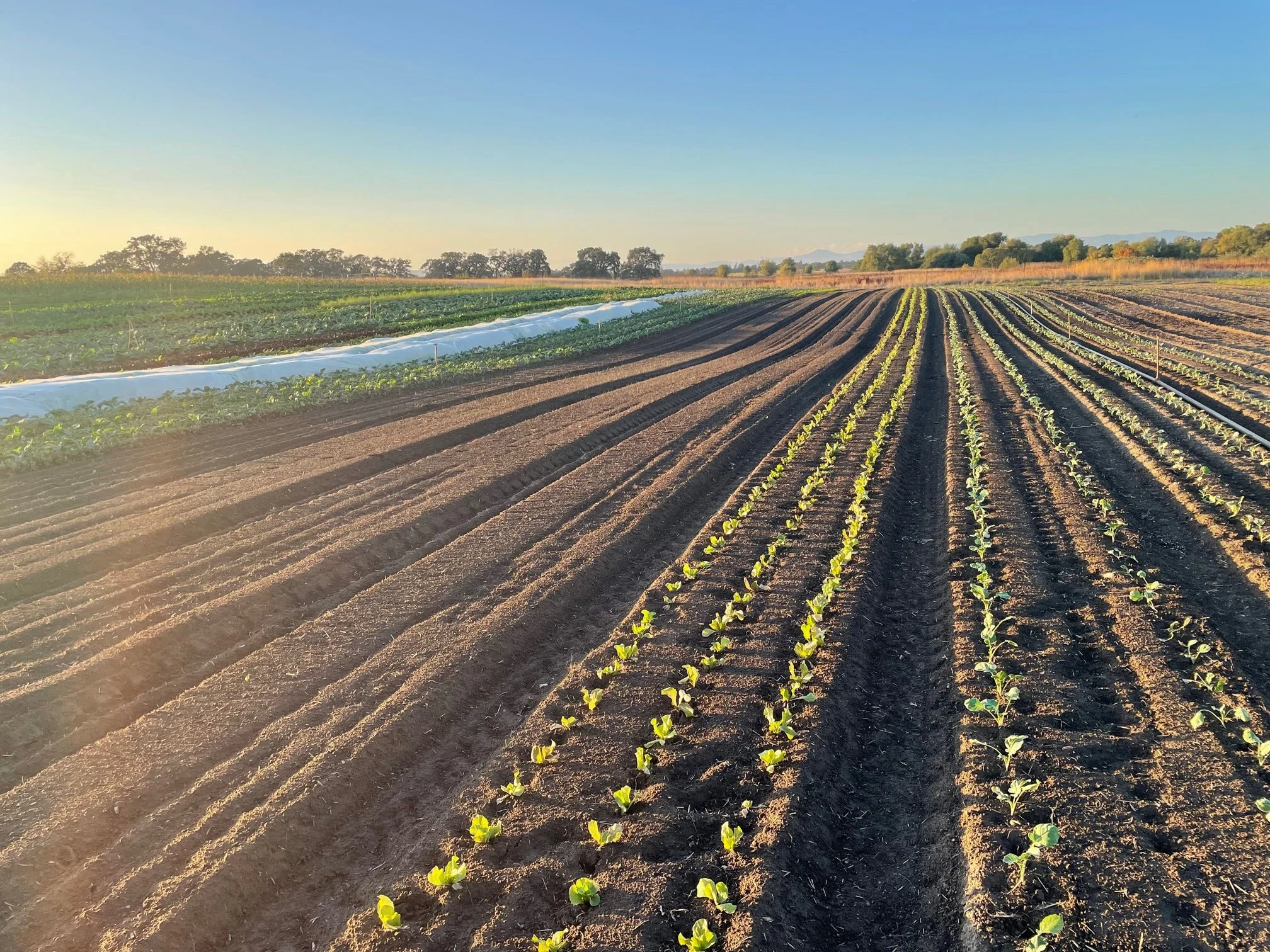It’s an exciting day at Green Valley tomorrow! Pick out your Jack-O-Lantern pumpkin; come join us in a quintessential agricultural ritual; help plant natives by the creek!
Potato Harvest PARTY!
TOMORROW, October 12th: 9:30am - 12:00pm
Lend a hand as we bag freshly unearthed potatoes for storage or just take in the scene and hang out. It’s an unforgettable experience. All abilities and interest levels welcome. For those coming to work we recommend light gloves, a water bottle, sun hat, and clothes you don’t mind getting dirty! Snacks welcome.
Native Riparian Hedgerow planting
Tomorrow, October 12th: 12:30pm - 3:00pm
Give back to the land! Join Aubrie as she leads the planting of a big a native riparian hedgerow along the fence by the creek as part of a grant Green Valley Farm + Mill received via California’s Healthy Soils Initiative!
They aren’t as big as Dr. Pumpy, pictured here, but there is a nice Jack-O-Lantern pumpkin waiting for you out on the farm!
THIS WEEK'S HARVEST
Delicata Winter Squash, Harvest Moon Purple Potatoes, Leeks, Scallions, Italian Softneck Garlic, Dazzling Blue Dino Kale, Napa Cabbage, Sweet Peppers, Mixed Loose Beets, Rainbow Chard, Daikon Radish, Summer Squash and Zucchini, Rainbow Carrots, Indigo Red Radicchio, Assorted Lettuce, Fancy Fall Salad Mix (Shungiku, Arugula, Mustard Greens, Frisee, Radicchio)
U-PICK
With the recent frosty nights, our cherry tomatoes, frying peppers, and strawberries are starting to slow down.
JACK-O-LANTERN PUMPKINS! 1 per share season season limit. (If you are sharing a share, please coordinate with your group as to who takes home your pumpkin.)
Classic Green Beans: Gleanings
Cherry Tomatoes: Gleanings
Herbs: Italian Basil, Tulsi Basil, Thai Basil, Purple Basil, Italian Parsley, Rosemary, Lemon balm, Lemon Verbena, Vietnamese Coriander, Cilantro, French Sorrel, Onion Chives, Garlic Chives, Tarragon, Oregano, Thyme, Chamomile, Mints, Anise Hyssop, Culinary Lavender, Lemongrass
Flowers! There some really nice new Zinnia and Cosmo beds to the left of the cherry tomatoes
Frying Peppers & Jalapeños: Gleanings.
Strawberries: Gleanings
HARVEST NOTES
Indigo Red Radicchio: This classic Italian radicchio is slightly more bitter than the Bel Fiore last week. Our favorite way to eat this radicchio is to quarter it, tossing it with oil and garlic and braising or broiling until slightly crisped and melting.
Delicata Winter Squash: Everyone’s favorite. Super sweet, super easy.
PRESERVING THE HARVEST
Kim-chi time!: You may have noticed, we have the holy tifecta of Kim-chi ingredients in the share this week: Napa cabbage, daikon, and scallions. This is not an accident! One of our all time favorite preserves, this spicy Korean ferment goes with everything. Try this vegan Temple Kim-chi recipe (our favorite), or this tried and true traditional Kim-chi recipe.
Bulk White Satin Carrots: Don’t underestimate the White Satin Carrot. We feel it is consistently our best tasting, sweetest carrot. It also happens to be extraordinarily vigorous. We’ll be putting out bulk White Satins on the back table for pickling, juicing, etc. Out of bag. Don’t be shy, take 10 pounds! Check out this wonderful recipe for pickling carrots… or any vegetable!
Hannah and Leland picking zinnias at golden hour
Sound Bite: A Synthesis of Food and music
Saturday, October 19th, 5:00pm-10:00pm
Need a date night idea? Come enjoy an evening on the fancy end of the land for an original fusion of tastes and tunes: Sound Bite, hosted by Green Valley Farm + Mill.
Foodnome home cooks are pairing up with local musicians, for a delicious & sensual evening of synesthesia. Enjoy a three course meal carefully curated by Foodnome cooks, perfectly paired with three musical performances.
Use discount code greenvalley and grab a seat for $50 for before they run out. BYOB or get some of Green Valley vineyard’s wine for $15/bottle. This event is going to be nothing short of magic.
VOLUNTEER WEDNESDAYS, 8:00-10:00 AM
Interested in some farm therapy? Come out on Wednesday mornings to help us tend the garden and farm together. Come find us in the garden or out in the main fields on Wednesdays from 8:00am 'til 10:00 am. All abilities welcome, we’ll find something comfortable for you to do!
FARMER’S LOG
A POTATO HARVEST
Tomorrow morning, we'll come together as a community to perform a quintessential agricultural ritual: We'll harvest potatoes. As we kneel down, on the Earth, digging through the soil and bagging the cool, bulbous tubers, we will join in concert thousands of people around the world performing the same act. We will also join untold millions of ancestors who, every Fall, knelt together and harvested potatoes. We will also be joined to a real living breathing chain of seed potatoes — to hundreds of harvests in Europe and Asia and to ten thousand harvests in the Andes and Northeastern Bolivia and those who first knelt, harvested, and saved seed potatoes.
There is nothing quite like a potato harvest and the feeling, afterwards, of storing them away in a cool dark place, a hole, a cellar, a cave; the potatoes themselves alive, breathing slowly, promising food, promising life, as Fall turns to Winter.
The highest caloric food crop per-acre in the world (over maize, wheat, and rice) potatoes are the only of these staple foods that forms (the food part, at least) deep in the Earth — shrouded in darkness and mystery until we lift it up, into light, together in the Fall.
Many have known the feeling of incredible abundance that the potatoes can give. And sadly, many have known the inverse. In 1845, due to limited potato genetics in the region and the cold shoulders of powerful men, a million people starved in poorer parts of Western Ireland and the Scottish highlands, as a blighted potato crop rotted in the fields. Indeed, the potato has been a powerful, joyful, and also painful bond between people and the Earth, in feast and in famine, for millennia.
The Irish poet Seamus Heaney speaks to this history in his poem, At a Potato Digging.
I.
A mechanical digger wrecks the drill,
Spins up a dark shower of roots and mould.
Labourers swarm in behind, stoop to fill
Wicker creels. Fingers go dead in the cold.
Like crows attacking crow-black fields, they stretch
A higgledy line from hedge to headland;
Some pairs keep breaking ragged ranks to fetch
A full creel to the pit and straighten, stand
Tall for a moment but soon stumble back
To fish a new load from the crumbled surf.
Heads bow, trucks bend, hands fumble towards the black
Mother. Processional stooping through the turf
Turns work to ritual. Centuries
Of fear and homage to the famine god
Toughen the muscles behind their humbled knees,
Make a seasonal altar of the sod.
II.
Flint-white, purple. They lie scattered
Like inflated pebbles. Native
to the blank hutch of clay
where the halved seed shot and clotted
these knobbed and slit-eyed tubers seem
the petrified hearts of drills. Split
by the spade, they show white as cream.
Good smells exude from crumbled earth.
The rough bark of humus erupts
knots of potatoes (a clean birth)
whose solid feel, whose wet inside
promises taste of ground and root.
To be piled in pits; live skulls, blind-eyed.
III.
Live skulls, blind-eyed, balanced on
wild higgledy skeletons
scoured the land in 'forty-five,'
wolfed the blighted root and died.
The new potato, sound as stone,
putrified when it had lain
three days in the long clay pit.
Millions rotted along with it.
Mouths tightened in, eyes died hard,
faces chilled to a plucked bird.
In a million wicker huts
beaks of famine snipped at guts.
A people hungering from birth,
grubbing, like plants, in the earth,
were grafted with a great sorrow.
Hope rotted like a marrow.
Stinking potatoes fouled the land,
pits turned pus in filthy mounds:
and where potato diggers are
you still smell the running sore.
IV.
Under a white flotilla of gulls
The rhythm deadens, the workers stop.
White bread and tea in bright canfuls
Are served for lunch. Dead-beat, they flop
Down in the ditch and take their fill,
Thankfully breaking timeless fasts;
Then, stretched on the faithless ground, spill
Libations of cold tea, scatter crusts.
******
At Green Valley Community Farm this year, we had a vigorous, healthy potato crop. The whole potato field in flower in August was a vision to behold, and scented the mornings with its sweet fragrance. All that energy, all that delight, was sent down below waiting to be brought into the light tomorrow morning and to nourish us this Fall. And that is cause for celebration.
Join us tomorrow as we "shower" up the living roots and scatter libations in remembrance and thanks at our 3rd annual potato harvest!
See you in the potato field,
David & Kayta














